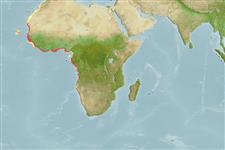>
Carangiformes (Jacks) >
Carangidae (Jacks and pompanos) > Caranginae
Etymology: Trachurus: Greek, trachys, -eia, -ys = rough + Greek, oura = tail (Ref. 45335).
Environment: milieu / climate zone / depth range / distribution range
Ökologie
seewasser; brackwasser benthopelagisch; tiefenbereich 20 - 100 m (Ref. 2683), usually 20 - 100 m (Ref. 54930). Tropical; 15°C - 22°C (Ref. 54930); 35°N - 19°S, 26°W - 14°E (Ref. 54930)
Eastern Atlantic: Morocco to Angola. Sometimes ranging south to northern Namibia (Ref. 27121).
Length at first maturity / Size / Gewicht / Alter
Maturity: Lm 24.1 range ? - ? cm
Max length : 35.0 cm FL Männchen/unbestimmt; (Ref. 7097); max. veröff. Gewicht: 2.0 kg (Ref. 27584)
Adults are sometimes found near the surface. They form schools (Ref. 2683). Commercial fishing trawlers catch this species at depths up to 650 m (J. Luyben, pers. Comm. 10/02). Adults feed mainly on crustaceans (Ref. 4233). Eggs are pelagic (Ref. 4233).
Life cycle and mating behavior
Geschlechtsreife | Fortpflanzung | Ablaichen | Eier | Fecundity | Larven
Smith-Vaniz, W.F., 1986. Carangidae. p. 815-844. In P.J.P. Whitehead, M.-L. Bauchot, J.-C. Hureau, J. Nielsen and E. Tortonese (eds.) Fishes of the north-eastern Atlantic and the Mediterranean. UNESCO, Paris. vol. 2. (Ref. 4233)
IUCN Rote Liste Status (Ref. 130435: Version 2024-1)
Bedrohung für Menschen
Harmless
Nutzung durch Menschen
Fischereien: hoch kommerziell
Tools
Zusatzinformationen
Download XML
Internet Quellen
Estimates based on models
Preferred temperature (Ref.
123201): 16.4 - 27.9, mean 24.4 °C (based on 146 cells).
Phylogenetic diversity index (Ref.
82804): PD
50 = 0.5001 [Uniqueness, from 0.5 = low to 2.0 = high].
Bayesian length-weight: a=0.01096 (0.00664 - 0.01810), b=2.95 (2.81 - 3.09), in cm total length, based on LWR estimates for this species & Genus-body shape (Ref.
93245).
Trophic level (Ref.
69278): 3.5 ±0.38 se; based on food items.
Generation time: 4.3 ( na - na) years. Estimated as median ln(3)/K based on 1
growth studies.
Widerstandsfähigkeit (Ref.
120179): mittel, Verdopplung der Population dauert 1,4 - 4,4 Jahre. (K=0.26).
Prior r = 1.10, 95% CL = 0.73 - 1.65, Based on 1 full stock assessment.
Fishing Vulnerability (Ref.
59153): Moderate vulnerability (36 of 100).
Climate Vulnerability (Ref.
125649): High vulnerability (57 of 100).
Nutrients (Ref.
124155): Calcium = 373 [217, 843] mg/100g; Iron = 2.93 [1.56, 5.92] mg/100g; Protein = 18.1 [17.0, 19.1] %; Omega3 = 0.204 [0.101, 0.404] g/100g; Selenium = 48.9 [25.0, 100.4] μg/100g; VitaminA = 40.3 [9.2, 167.2] μg/100g; Zinc = 3.63 [2.38, 5.80] mg/100g (wet weight); based on
nutrient studies.
